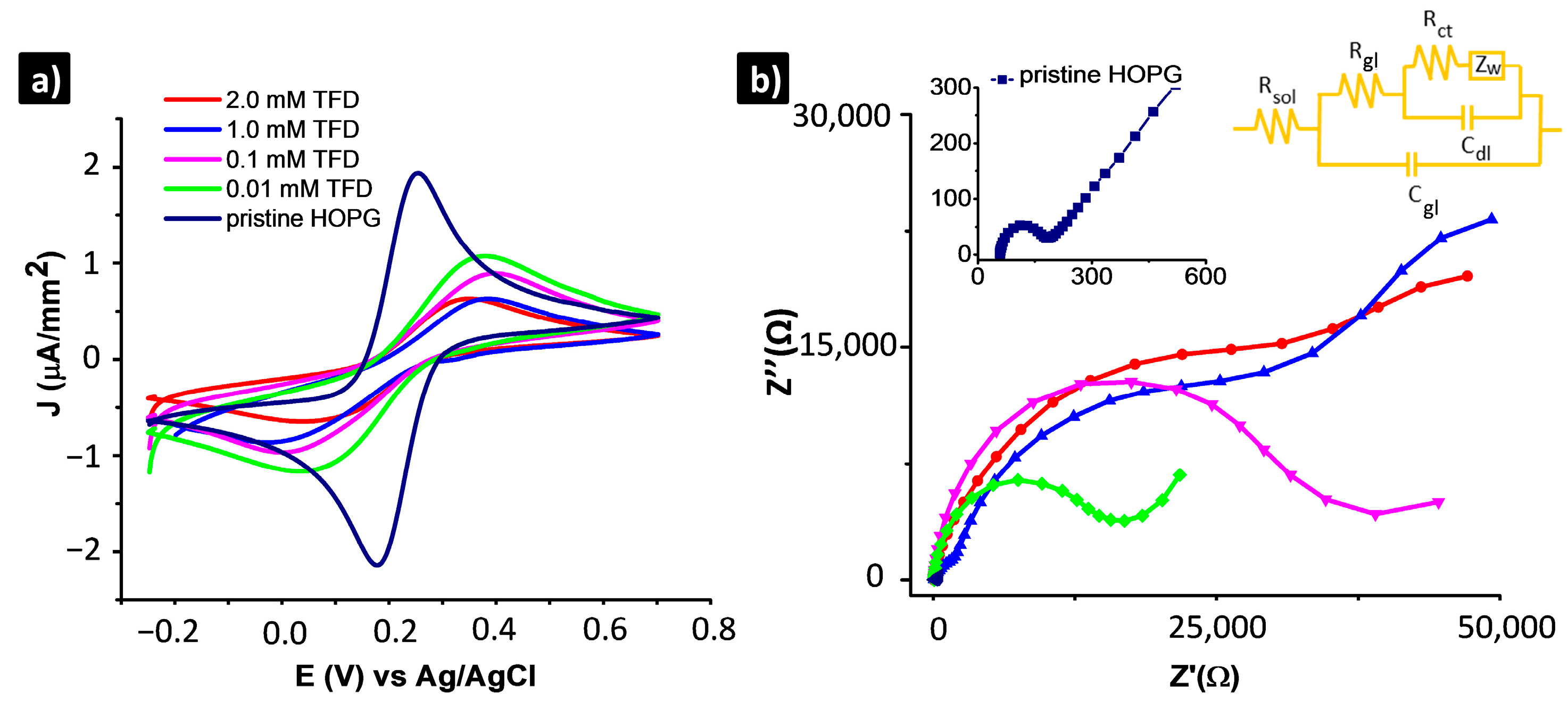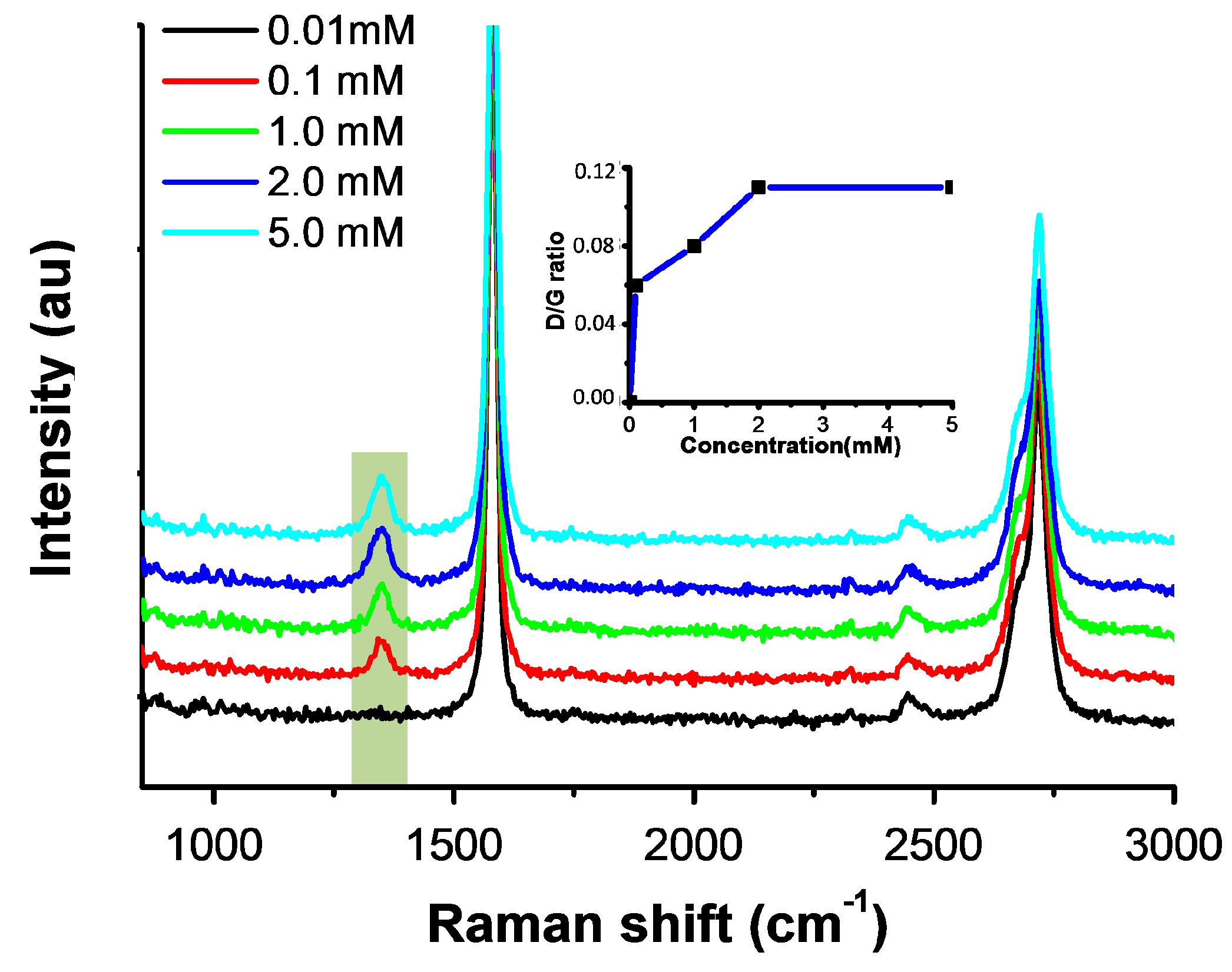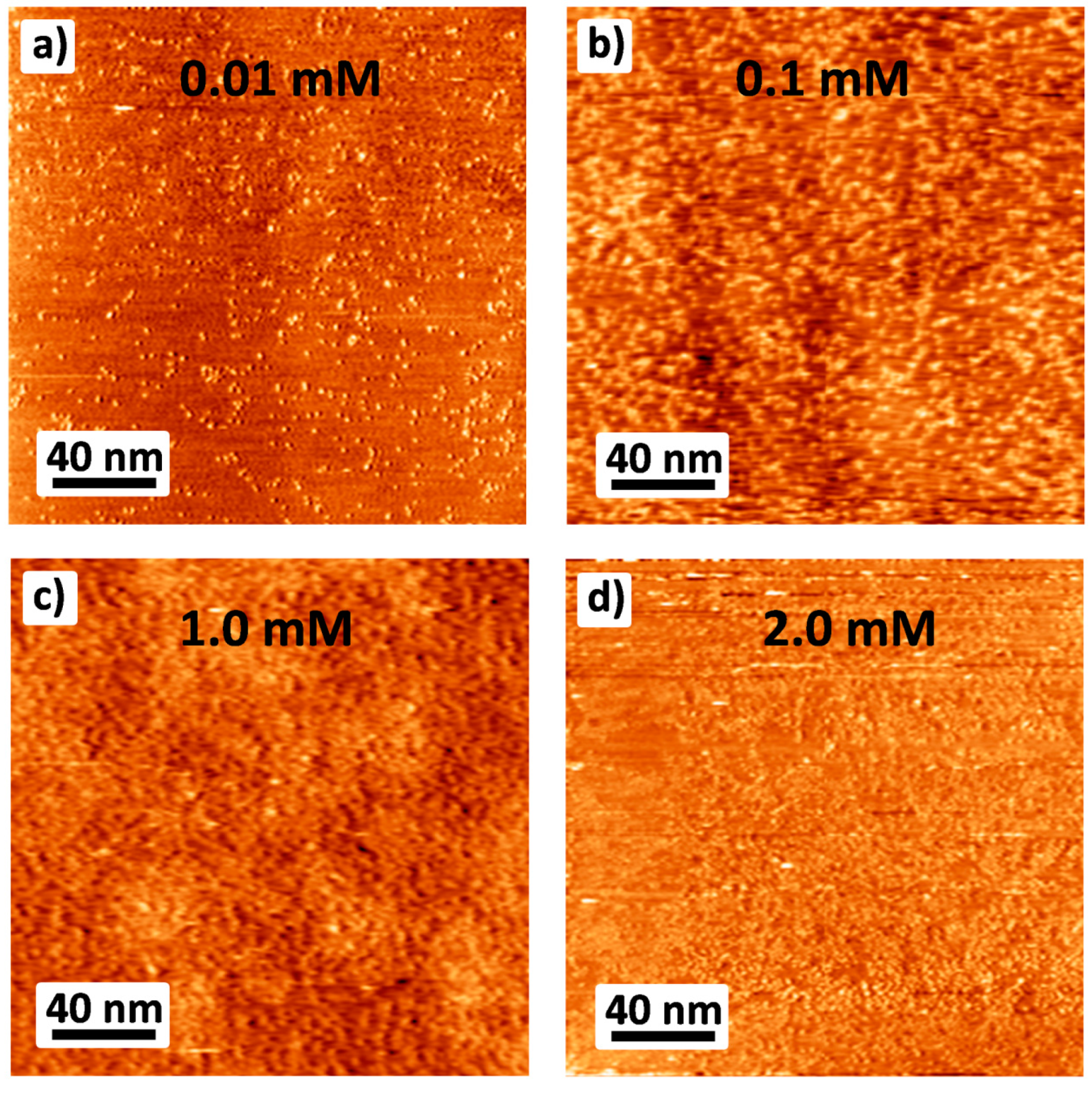Reversible Tuning of Surface Properties of Graphene-like Material via Covalently Functionalized Hydrophobic Layer
Abstract
1. Introduction
2. Materials and Methods
3. Results
3.1. Concentration-Dependent Electrografting of HOPG Electrode
3.2. Electrochemical and Structural Properties of the 3,5-TFD-GraftedHOPG
3.3. Global vs. Local Defunctionalization of the 3,5-TFD-Grafted Layer
4. Conclusions
Author Contributions
Funding
Institutional Review Board Statement
Informed Consent Statement
Data Availability Statement
Acknowledgments
Conflicts of Interest
References
- Geim, A.K. Graphene: Status and Prospects. Science 2009, 324, 1530–1534. [Google Scholar] [CrossRef] [PubMed]
- Stergiou, A.; Cantón-Vitoria, R.; Psarrou, M.N.; Economopoulos, S.P.; Tagmatarchis, N. Functionalized graphene and targeted applications—Highlighting the road from chemistry to applications. Prog. Mater. Sci. 2020, 114, 100683. [Google Scholar] [CrossRef]
- Maio, A.; Pibiri, I.; Morreale, M.; La Mantia, F.P.; Scaffaro, R. An Overview of Functionalized Graphene Nanomaterials for Advanced Applications. Nanomaterials 2021, 11, 1717. [Google Scholar] [CrossRef]
- Karki, N.; Tiwari, H.; Tewari, C.; Rana, A.; Pandey, N.; Basak, S.; Sahoo, N.G. Functionalized graphene oxide as a vehicle for targeted drug delivery and bioimaging applications. J. Mater. Chem. B 2020, 8, 8116–8148. [Google Scholar] [CrossRef]
- Yang, G.-H.; Bao, D.-D.; Liu, H.; Zhang, D.-Q.; Wang, N.; Li, H.-T. Functionalization of Graphene and Applications of the Derivatives. J. Inorg. Organomet. Polym. Mater. 2017, 27, 1129–1141. [Google Scholar] [CrossRef]
- Du, Y.; Dong, N.; Zhang, M.; Zhu, K.; Na, R.; Zhang, S.; Sun, N.; Wang, G.; Wang, J. Covalent functionalization of graphene oxide with porphyrin and porphyrin incorporated polymers for optical limiting. Phys. Chem. Chem. Phys. 2017, 19, 2252–2260. [Google Scholar] [CrossRef]
- Pawlak, R.; Liu, X.; Ninova, S.; D’Astolfo, P.; Drechsel, C.; Sangtarash, S.; Häner, R.; Decurtins, S.; Sadeghi, H.; Lambert, C.J.; et al. Bottom-up Synthesis of Nitrogen-Doped Porous Graphene Nanoribbons. J. Am. Chem. Soc. 2020, 142, 12568–12573. [Google Scholar] [CrossRef]
- Bottari, G.; Ángeles Herranz, M.; Wibmer, L.; Volland, M.; Rodríguez-Pérez, L.; Guldi, D.M.; Hirsch, A.; Martín, N.; D’Souza, F.; Torres, T. Chemical functionalization and characterization of graphene-based materials. Chem. Soc. Rev. 2017, 46, 4464–4500. [Google Scholar] [CrossRef]
- Huynh, T.M.T.; Phan, T.H.; De Feyter, S. Surface Engineering of Graphite and Graphene by Viologen Self-Assembling: From Global to Local Architectures. J. Phys. Chem. C 2022, 126, 6413–6419. [Google Scholar] [CrossRef]
- Huynh, T.M.T.; Phan, T.H.; Phillipson, R.; Volodine, A.; De Feyter, S. Doping of graphene via adlayer formation of electrochemically reduced dibenzyl viologen. J. Mater. Chem. C 2022, 10, 2696–2702. [Google Scholar] [CrossRef]
- Balandina, T.; Tahara, K.; Sändig, N.; Blunt, M.O.; Adisoejoso, J.; Lei, S.; Zerbetto, F.; Tobe, Y.; De Feyter, S. Role of Substrate in Directing the Self-Assembly of Multicomponent Supramolecular Networks at the Liquid–Solid Interface. ACS Nano 2012, 6, 8381–8389. [Google Scholar] [CrossRef] [PubMed]
- Velpula, G.; Takeda, T.; Adisoejoso, J.; Inukai, K.; Tahara, K.; Mali, K.S.; Tobe, Y.; De Feyter, S. On the formation of concentric 2D multicomponent assemblies at the solution–solid interface. Chem. Commun. 2017, 53, 1108–1111. [Google Scholar] [CrossRef] [PubMed]
- Zhan, G.; Cai, Z.-F.; Strutyński, K.; Yu, L.; Herrmann, N.; Martínez-Abadía, M.; Melle-Franco, M.; Mateo-Alonso, A.; De Feyter, S. Observing polymerization in 2D dynamic covalent polymers. Nature 2022, 603, 835–840. [Google Scholar] [CrossRef] [PubMed]
- Arranz-Mascarós, P.; Godino-Salido, M.L.; López-Garzón, R.; García-Gallarín, C.; Chamorro-Mena, I.; López-Garzón, F.J.; Fernández-García, E.; Gutiérrez-Valero, M.D. Non-covalent Functionalization of Graphene to Tune Its Band Gap and Stabilize Metal Nanoparticles on Its Surface. ACS Omega 2020, 5, 18849–18861. [Google Scholar] [CrossRef]
- Bouchareb, S.; Doufnoune, R.; Riahi, F.; Cherif-Silini, H.; Belbahri, L. Non-covalent functionalization of graphene oxide using self-assembly of silver-triphenylphosphine for bactericidal formulations. Mater. Chem. Phys. 2019, 243, 122598. [Google Scholar] [CrossRef]
- Gobbi, M.; Bonacchi, S.; Lian, J.X.; Liu, Y.; Wang, X.-Y.; Stoeckel, M.-A.; Squillaci, M.A.; D’Avino, G.; Narita, A.; Müllen, K.; et al. Periodic potentials in hybrid van der Waals heterostructures formed by supramolecular lattices on graphene. Nat. Commun. 2017, 8, 14767. [Google Scholar] [CrossRef]
- Greenwood, J.; Phan, T.H.; Fujita, Y.; Li, Z.; Ivasenko, O.; Vanderlinden, W.; Van Gorp, H.; Frederickx, W.; Lu, G.; Tahara, K.; et al. Covalent Modification of Graphene and Graphite Using Diazonium Chemistry: Tunable Grafting and Nanomanipulation. ACS Nano 2015, 9, 5520–5535. [Google Scholar] [CrossRef]
- Fan, K.; Liu, X.; Liu, Y.; Li, Y.; Chen, Y.; Meng, Y.; Liu, X.; Feng, W.; Luo, L. Covalent functionalization of fluorinated graphene through activation of dormant radicals for water-based lubricants. Carbon 2020, 167, 826–834. [Google Scholar] [CrossRef]
- Meng, C.; Chen, Q.; Li, X.; Liu, H. Controlling covalent functionalization of graphene oxide membranes to improve enantioseparation performances. J. Membr. Sci. 2019, 582, 83–90. [Google Scholar] [CrossRef]
- Nandanapalli, K.R.; Mudusu, D.; Lee, S. Functionalization of graphene layers and advancements in device applications. Carbon 2019, 152, 954–985. [Google Scholar] [CrossRef]
- Ambrosio, G.; Brown, A.; Daukiya, L.; Drera, G.; Di Santo, G.; Petaccia, L.; De Feyter, S.; Sangaletti, L.; Pagliara, S. Impact of covalent functionalization by diazonium chemistry on the electronic properties of graphene on SiC. Nanoscale 2020, 12, 9032–9037. [Google Scholar] [CrossRef]
- González, M.C.R.; Leonhardt, A.; Stadler, H.; Eyley, S.; Thielemans, W.; De Gendt, S.; Mali, K.S.; De Feyter, S. Multicomponent Covalent Chemical Patterning of Graphene. ACS Nano 2021, 15, 10618–10627. [Google Scholar] [CrossRef] [PubMed]
- Hossain, Z.; Walsh, M.A.; Hersam, M.C. Scanning Tunneling Microscopy, Spectroscopy, and Nanolithography of Epitaxial Graphene Chemically Modified with Aryl Moieties. J. Am. Chem. Soc. 2010, 132, 15399–15403. [Google Scholar] [CrossRef] [PubMed]
- Hetemi, D.; Noël, V.; Pinson, J. Grafting of Diazonium Salts on Surfaces: Application to Biosensors. Biosens. 2020, 10, 4. [Google Scholar] [CrossRef]
- Mattiuzzi, A.; Lenne, Q.; Padilha, J.C.; Troian-Gautier, L.; Leroux, Y.R.; Jabin, I.; Lagrost, C. Strategies for the Formation of Monolayers From Diazonium Salts: Unconventional Grafting Media, Unconventional Building Blocks. Front. Chem. 2020, 8, 559. [Google Scholar] [CrossRef] [PubMed]
- Menanteau, T.; Levillain, E.; Breton, T. Spontaneous Grafting of Nitrophenyl Groups on Carbon: Effect of Radical Scavenger on Organic Layer Formation. Langmuir 2014, 30, 7913–7918. [Google Scholar] [CrossRef]
- González, M.C.R.; Orive, A.G.; Salvarezza, R.C.; Creus, A.H. Electrodeposition of gold nanoparticles on aryl diazonium monolayer functionalized HOPG surfaces. Phys. Chem. Chem. Phys. 2015, 18, 1953–1960. [Google Scholar] [CrossRef]
- Menanteau, T.; Dias, M.; Levillain, E.; Downard, A.J.; Breton, T. Electrografting via Diazonium Chemistry: The Key Role of the Aryl Substituent in the Layer Growth Mechanism. J. Phys. Chem. C 2016, 120, 4423–4429. [Google Scholar] [CrossRef]
- González, M.C.R.; Brown, A.; Eyley, S.; Thielemans, W.; Mali, K.S.; De Feyter, S. Self-limiting covalent modification of carbon surfaces: Diazonium chemistry with a twist. Nanoscale 2020, 12, 18782–18789. [Google Scholar] [CrossRef]
- Xia, Y.; Martin, C.; Seibel, J.; Eyley, S.; Thielemans, W.; van der Auweraer, M.; Mali, K.S.; De Feyter, S. Iodide mediated reductive decomposition of diazonium salts: Towards mild and efficient covalent functionalization of surface-supported graphene. Nanoscale 2020, 12, 11916–11926. [Google Scholar] [CrossRef]
- Pandurangappa, M.; Ramakrishnappa, T. Derivatization and characterization of functionalized carbon powder via diazonium salt reduction. J. Solid State Electrochem. 2008, 12, 1411–1419. [Google Scholar] [CrossRef]
- Phan, T.H.; Van Gorp, H.; Li, Z.; Huynh, T.M.T.; Fujita, Y.; Verstraete, L.; Eyley, S.; Thielemans, W.; Uji-i, H.; Hirsch, B.E.; et al. Graphite and Graphene Fairy Circles: A Bottom-Up Approach for the Formation of Nanocorrals. ACS Nano 2019, 13, 5559–5571. [Google Scholar] [CrossRef] [PubMed]
- Medeiros, P.V.; Gueorguiev, G.; Stafström, S. Bonding, charge rearrangement and interface dipoles of benzene, graphene, and PAH molecules on Au(1 1 1) and Cu(1 1 1). Carbon 2014, 81, 620–628. [Google Scholar] [CrossRef]
- Van Gorp, H.; Walke, P.; Teyssandier, J.; Hirsch, B.E.; Uji-i, H.; Tahara, K.; Tobe, Y.; Van der Auweraer, M.; De Feyter, S. On the Thermal Stability of Aryl Groups Chemisorbed on Graphite. J. Phys. Chem. C 2020, 124, 1980–1990. [Google Scholar] [CrossRef]
- Horcas, I.; Fernández, R.; Gómez-Rodriguez, J.M.; Colchero, J.; Gomez-Herrero, J.; Baro, A.M. WSXM: A software for scanning probe microscopy and a tool for nanotechnology. Rev. Sci. Instrum. 2007, 78, 13705. [Google Scholar] [CrossRef] [PubMed]
- Tahara, K.; Kubo, Y.; Lindner, B.D.; Hashimoto, S.; Hirose, S.; Brown, A.; Hirsch, B.E.; Daukiya, L.; De Feyter, S.; Tobe, Y. Steric and Electronic Effects of Electrochemically Generated Aryl Radicals on Grafting of the Graphite Surface. Langmuir 2019, 35, 2089–2098. [Google Scholar] [CrossRef]
- Yamasaki, R.; Takatsuji, Y.; Lienemann, M.; Asakawa, H.; Fukuma, T.; Linder, M.; Haruyama, T. Electrochemical properties of honeycomb-like structured HFBI self-organized membranes on HOPG electrodes. Colloids Surf. B Biointerfaces 2014, 123, 803–808. [Google Scholar] [CrossRef]
- Yin, K.M.; Lu, L.I. Parametric study on the electrochemical impedance spectroscopy of organic-coated steels in hydrochloric acid solutions. J. Coat. Technol. 2003, 75, 65–72. [Google Scholar] [CrossRef]
- Wang, Q.H.; Jin, Z.; Kim, K.K.; Hilmer, A.J.; Paulus, G.L.C.; Shih, C.-J.; Ham, M.-H.; Sanchez-Yamagishi, J.; Watanabe, K.; Taniguchi, T.; et al. Understanding and controlling the substrate effect on graphene electron-transfer chemistry via reactivity imprint lithography. Nat. Chem. 2012, 4, 724–732. [Google Scholar] [CrossRef]
- Niyogi, S.; Bekyarova, E.; Itkis, M.E.; Zhang, H.; Shepperd, K.; Hicks, J.; Sprinkle, M.; Berger, C.; Lau, C.N.; Deheer, W.A.; et al. Spectroscopy of Covalently Functionalized Graphene. Nano Lett. 2010, 10, 4061–4066. [Google Scholar] [CrossRef]
- Malard, L.M.; Pimenta, M.A.; Dresselhaus, G.; Dresselhaus, M.S. Raman spectroscopy in graphene. Phys. Rep. 2009, 473, 51–87. [Google Scholar] [CrossRef]





Disclaimer/Publisher’s Note: The statements, opinions and data contained in all publications are solely those of the individual author(s) and contributor(s) and not of MDPI and/or the editor(s). MDPI and/or the editor(s) disclaim responsibility for any injury to people or property resulting from any ideas, methods, instructions or products referred to in the content. |
© 2023 by the authors. Licensee MDPI, Basel, Switzerland. This article is an open access article distributed under the terms and conditions of the Creative Commons Attribution (CC BY) license (https://creativecommons.org/licenses/by/4.0/).
Share and Cite
Huynh, T.M.T.; Nguyen, D.D.; Hoang, N.H.; Phan, T.H. Reversible Tuning of Surface Properties of Graphene-like Material via Covalently Functionalized Hydrophobic Layer. Crystals 2023, 13, 635. https://doi.org/10.3390/cryst13040635
Huynh TMT, Nguyen DD, Hoang NH, Phan TH. Reversible Tuning of Surface Properties of Graphene-like Material via Covalently Functionalized Hydrophobic Layer. Crystals. 2023; 13(4):635. https://doi.org/10.3390/cryst13040635
Chicago/Turabian StyleHuynh, Thi Mien Trung, Duy Dien Nguyen, Nhat Hieu Hoang, and Thanh Hai Phan. 2023. "Reversible Tuning of Surface Properties of Graphene-like Material via Covalently Functionalized Hydrophobic Layer" Crystals 13, no. 4: 635. https://doi.org/10.3390/cryst13040635
APA StyleHuynh, T. M. T., Nguyen, D. D., Hoang, N. H., & Phan, T. H. (2023). Reversible Tuning of Surface Properties of Graphene-like Material via Covalently Functionalized Hydrophobic Layer. Crystals, 13(4), 635. https://doi.org/10.3390/cryst13040635





